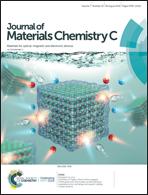Eco-friendly and high-performance photoelectrochemical anode based on AgInS2 quantum dots embedded in 3D graphene nanowalls†
Abstract
Photoelectrochemical (PEC) cells offer a promising approach for developing a solar energy conversion system to resolve the increasingly serious energy crisis and environmental issues. However, the lack of stable and eco-friendly electrodes hampers their practical applications. Herein, we prepare an eco-friendly photoanode with enhanced PEC performance embedding AgInS2 quantum dots (QDs) into three-dimensional (3D) graphene nanowalls (GNWs). AgInS2 QDs with tunable PL emissions are synthesized using a facile hydrothermal method and then deposited on GNWs directly grown on silica by a catalyst-free method. Benefitting from the interconnected 3D conductive network, GNWs act as an outstanding electron acceptor to transport the photogenerated carriers of AgInS2 QDs. The experimental results demonstrate that the AgInS2/GNWs photoanodes exhibit rapid photoresponse upon light excitation with comparable short rise-time (0.23 s) and decay-time (0.41 s). By optimizing the reaction temperature of the QDs, a photo-current density of 145 μA cm−2 can be achieved due to the effective separation of the photogenerated carriers. Meanwhile, the as-prepared photoanodes exhibit excellent stability of the photoresponse for more than 4000 s of on–off switching and one-month duration. Our study provides a new strategy to construct an eco-friendly PEC system with high performance which shows potential applications for PEC-type devices.



 Please wait while we load your content...
Please wait while we load your content...